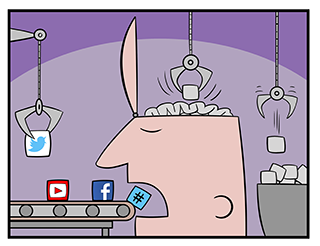Who Decides What You See On Social Media?

If your Facebook or Instagram account is anything like our accounts, your personal feed is filled with messages from your friends. Many people mistakenly believe that our feed is updated instantly whenever a friend posts something new, but this is not how it works.
On most social media platforms, there is nothing accidental about the messages we see in our timeline. A computer program decides what messages we should see. If you have ever heard people mention “the Facebook algorithm,” this is what they mean. Almost all social media platforms use some sort of algorithm to shape our content.
Consider the case of a young woman named Julia who leaves for college just one week after the family gets a new puppy. To fill the puppy-sized hole in her heart, Julia watches cute animal videos on YouTube and follows several famous pups on Instagram. Within a few days, her social media feeds are dominated by videos and images featuring puppies, kittens, and other small fluffy animals. While you may not have had this exact experience, you might have noticed that social media platforms suggest content that aligns with your ever-changing interests.
From the moment that you created an account on a social media platform, the company began gathering data about what you like and dislike. You might remember being asked what topics you find most interesting. Do you like to cook, play sports, debate politics, or paint? Are you obsessed with a certain, band, blogger, or YouTuber? After gathering this information, the platform is able to start streaming content that is specifically tailored to you. Every time you watch a video or link to a funny meme, social media platforms gather that piece of information in order to feed you more of this content.
On the one hand, the individualized content is amazing. We don’t need to search endlessly for something to see because social media algorithms are always ready to serve up another tasty tidbit of interesting information. Rather than everyone getting the same clear flow of information, each person’s stream of information is clouded by their likes and dislikes. A simple way to see how each platform tailors content for each person, compare the “suggested” or “explore” feature of a social media platform like Instagram with a friend. Even if you and your friend have similar interests, it is likely that the feeds will show different content.
These customized news streams are convenient, but they also cause problems. For one thing, we are not able to see the guidelines and rules that the algorithm uses to filter posts on our page. Every once in a while, Facebook and Instagram will drop a few hints about how these decisions are made, but each network is governed by an opaque algorithm. We cannot see underneath the hood, we don’t know why the platform deemed certain messages worthy of our attention, and we are not allowed to change the algorithm on our own.
Furthermore, by emphasizing messages aligned with our interests and personal preferences, these algorithms filter out information that might challenge our beliefs. When we fall into an echo-chamber of approving voices, it can seem like everyone agrees with us, and it becomes easy to block contradictory messages.
While we cannot be sure of the effect that social media has on our political beliefs, it is vital that we understand that news we see online has been selected just for us based on our likes, our dislikes, and the influence of third parties who have paid to place their message in front of us.
